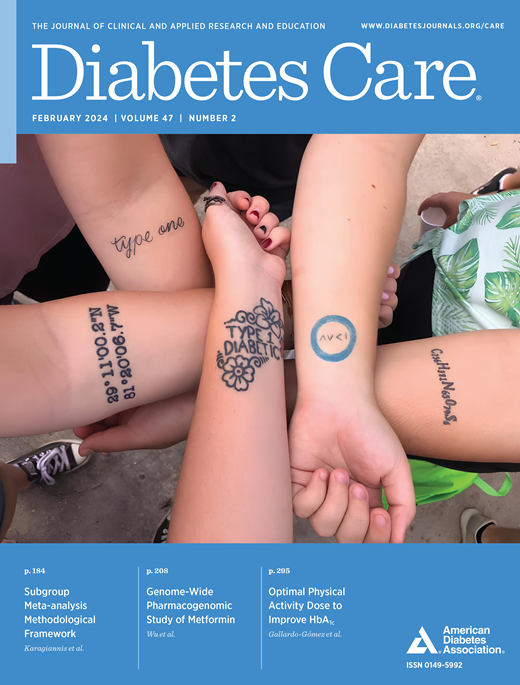2型糖尿病早期β细胞功能和血糖的改善在胰岛素治疗后放大的血糖阈值:葡萄糖毒性的逆转
IF 14.8
1区 医学
Q1 ENDOCRINOLOGY & METABOLISM
引用次数: 0
摘要
目的 减轻未被发现的葡萄糖毒性,从而恢复β细胞功能,这可能会增强药物治疗的降糖效果,并有助于在 2 型糖尿病(T2D)患者中观察到不同的治疗反应。然而,支持这一观点的临床证据还很缺乏。短期强化胰岛素疗法(IIT)可改善葡萄糖毒性,并改善早期 T2D 患者的 β 细胞功能。因此,为了获得葡萄糖毒性相关的β细胞功能障碍恢复的证据,我们试图确定是否存在一个基线空腹血糖阈值,超过该阈值,胰岛素强化治疗后β细胞功能和血糖的改善都会被放大。研究设计与方法 对 108 名患有 T2D 的成人(平均病程为 1.8 ± 1.4 年)进行为期 3 周的 IIT(格列奈,利血平)治疗。在 IIT 之前和之后进行口服葡萄糖耐量试验,通过胰岛素分泌-敏感性指数-2 和胰岛素生成指数/HOMA-胰岛素抵抗评估β细胞功能。对于从 6.0 到 10.5 mmol/L 的每个基线空腹血糖水平,我们模拟了 IIT 引起的 β 细胞功能百分比变化在处于/高于指定血糖水平和低于指定血糖水平之间的差异。结果 基线空腹血糖与 β 细胞功能差异变化之间的关系是非线性的。相反,立方回归模型最适合这种关系,在空腹血糖为 9.3 mmol/L 时出现拐点(放大)。此外,基线空腹血糖为 9.3 mmol/L,也是空腹血糖和 2 小时血糖非线性下降均被放大的拐点。结论 短期 IIT 对 β 细胞功能和血糖的改善在基线空腹血糖超过规定阈值时会被放大,这与葡萄糖毒性的逆转是一致的。本文章由计算机程序翻译,如有差异,请以英文原文为准。
A Glycemic Threshold Above Which the Improvement of β-Cell Function and Glycemia in Response to Insulin Therapy Is Amplified in Early Type 2 Diabetes: The Reversal of Glucotoxicity
OBJECTIVE Alleviation of unrecognized glucotoxicity, with resultant recovery of β-cell function, could amplify the glucose-lowering effect of pharmacotherapy and contribute to the variable therapeutic response observed among patients with type 2 diabetes (T2D). However, clinical evidence supporting this concept is lacking. Short-term intensive insulin therapy (IIT) can ameliorate glucotoxicity and improve β-cell function in early T2D. Thus, for evidence of recovery of glucotoxicity-associated β-cell dysfunction, we sought to determine whether there exists a baseline fasting glucose threshold above which the post-IIT improvement in both β-cell function and glycemia is amplified. RESEARCH DESIGN AND METHODS IIT (glargine, lispro) was administered for 3 weeks to 108 adults with T2D (mean duration 1.8 ± 1.4 years). Oral glucose tolerance tests before and after IIT enabled assessment of β-cell function by Insulin Secretion-Sensitivity Index-2 and insulinogenic index/HOMA-insulin resistance. For each level of baseline fasting glycemia from 6.0 to 10.5 mmol/L, we modeled the difference in IIT-induced percentage change in β-cell function between those at/above the indicated glucose level and those below it. RESULTS The relationship between baseline fasting glucose and the differential change in β-cell function was nonlinear. Instead, this relationship was best fit by a cubic regression model with inflection (amplification) at fasting glucose at 9.3 mmol/L. Moreover, baseline fasting glucose at 9.3 mmol/L also identified the inflection point at which nonlinear reductions in fasting glucose and 2-h glucose, respectively, were both amplified. CONCLUSIONS The respective improvements in β-cell function and glycemia in response to short-term IIT are amplified in those in whom baseline fasting glucose exceeds a defined threshold, consistent with reversal of glucotoxicity.
求助全文
通过发布文献求助,成功后即可免费获取论文全文。
去求助
来源期刊

Diabetes Care
医学-内分泌学与代谢
CiteScore
27.80
自引率
4.90%
发文量
449
审稿时长
1 months
期刊介绍:
The journal's overarching mission can be captured by the simple word "Care," reflecting its commitment to enhancing patient well-being. Diabetes Care aims to support better patient care by addressing the comprehensive needs of healthcare professionals dedicated to managing diabetes.
Diabetes Care serves as a valuable resource for healthcare practitioners, aiming to advance knowledge, foster research, and improve diabetes management. The journal publishes original research across various categories, including Clinical Care, Education, Nutrition, Psychosocial Research, Epidemiology, Health Services Research, Emerging Treatments and Technologies, Pathophysiology, Complications, and Cardiovascular and Metabolic Risk. Additionally, Diabetes Care features ADA statements, consensus reports, review articles, letters to the editor, and health/medical news, appealing to a diverse audience of physicians, researchers, psychologists, educators, and other healthcare professionals.
 求助内容:
求助内容: 应助结果提醒方式:
应助结果提醒方式:


